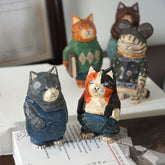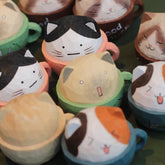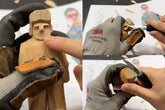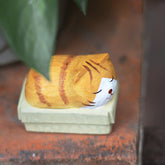Making Wooden Gifts That Look Good: A Guide to Proportions
In this blog, we’ll take a closer look at the composition logic behind different styles of wooden gifts. We’ll walk you through the basic concepts of proportion in human-shaped wood figurines and how to set the proportions and lengths you want for your own work.
First, let’s check out a series of wood figurines carved by various artists.

Even though the characters these artists created might look “oddly shaped,” the fact is that their proportions still maintain a certain balance. That balance is super important. It shows not only their skill in managing distortion and exaggeration but also that they were following a personal logic in how they approached the carving.

Sometimes, that logic isn’t easy to explain—viewers might not be able to describe it clearly, and the carvers themselves might not try to explain it—but the outcome aligns with the idea behind it, and that’s what makes it feel cohesive.
From a character design and illustration perspective, being able to distort the figure while keeping it logical usually starts with learning either realistic or comic-style proportions. That takes a lot of practice with human body ratios and expressive poses. In 2D, it also involves perspective, color, and spatial relationships.

For us, working with standalone 3D wood figurines, we don’t need to do tons of sketching, but it’s still really helpful to understand the basic human proportions and how they can vary in relation to each other.

What kinds of composition ratios are used for human-shaped wooden gifts?
Let’s start by learning two concepts: head-to-body ratio and shoulder-width ratio.
When studying body proportions, we typically use the head length (not including hair) as the base unit to measure other parts of the body. Different head-to-body ratios create different visual effects. In the image you see here, the ratio is either 7 or 7.5 heads tall. That’s considered a normal human body proportion, often used to represent balanced figures. Most comic styles stick to that kind of ratio.

The shoulder-width ratio uses the head’s width to determine shoulder width. For women, it’s generally about 1.5 head widths—so the space from shoulder to shoulder equals one and a half heads. For men, it’s closer to two heads wide.

Of course, if you want the male figure to look more muscular, you can increase the width to 2.5 heads. Just don’t go over 3 heads wide—that’ll make the figure look weird. For women, you can go from 1.5 to 1.8, maybe up to 2, but more than that and she’ll start to look too bulky, which usually doesn’t look good.
For child-like wood figurines, the overall height is about 5 head lengths.
How should you set the length proportions for human-shaped wooden gifts?
The figure shown here has a 9-head proportion, which is kind of the ideal. In real life, almost nobody actually has that kind of proportion. Supermodels or fashion sketches typically follow this 9-head style. An 8-head figure is more like an elegant adult woman.

7-heads is what we mentioned earlier as a common body proportion. 6-heads looks a little cuter—the upper body is shorter, and the legs can be stretched a bit longer. 5-heads is good for teenagers or younger kids.
2-head and 1-head figures are usually cartoon characters. In Japanese anime, you often see 1-head and 2-head figures. Take this Bojji wood figurine, for example—he’s about 2.5 heads tall, which gives him that super cute look.












